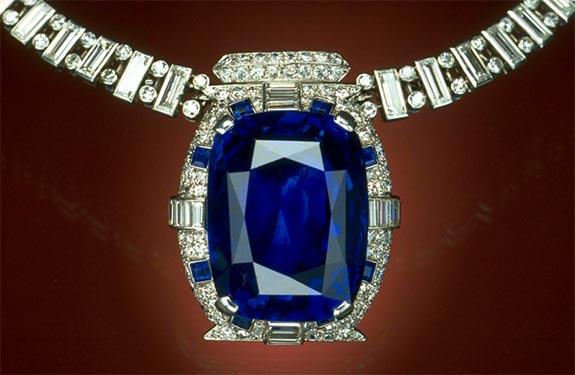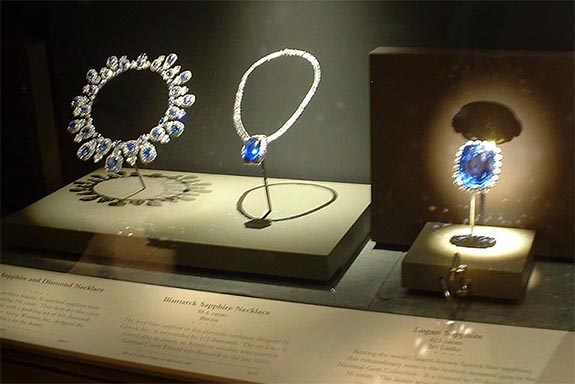September 5th, 2017
In 1926, at the age of 53, American tycoon Harrison Williams married Mona Bush, a divorcée 24 years his junior. Aboard his 250-foot yacht, the Warrior, the couple departed on a year-long, around-the-world honeymoon, and during a stopover in Sri Lanka (then Ceylon), the wealthiest man in America picked up a beautiful cornflower blue bauble for his new bride.

That 98.57-carat cushion-cut gem, which is now known as the Bismarck Sapphire, is one of the world's finest examples of September's official birthstone. Visitors to the Gem Gallery at the National Museum of Natural History in Washington, D.C., will see the Bismarck Sapphire Necklace prominently displayed between two other famous sapphire pieces, the Hall Sapphire and Diamond Necklace and the Logan Sapphire.

Originally set horizontally in a necklace designed by Cartier in 1927, the Bismarck Sapphire was rotated into a vertical position when Mona had the necklace updated in 1959. The necklace on display in Washington, D.C., is accented with eight square-cut blue sapphires and 312 baguette and round brilliant-cut diamonds.
Gem experts believe that the Bismarck Sapphire was originally much larger than 98.57 carats and that it was likely recut by Cartier to attain optimum clarity and brilliance after returning to the states from Sri Lanka. Traditionally, Sri Lankan cutters favored carat weight over ideal proportions.
With investments in public utilities, Williams had amassed a fortune estimated at $680 million (equivalent to about $9.6 billion today) — making him the richest man in America. But, the stock market crash of 1929 dissolved his fortune to a mere $5 million.
Still, the Williamses maintained their ritzy lifestyle and, by 1933, Mona had earned the distinction of becoming the first American voted the "Best Dressed Woman in the World."
Harrison Williams died in 1953, and two years later Mona would marry the German Count Eduard von Bismarck. At this point, the American socialite became known as Countess Mona von Bismarck. In 1967, at the age of 70, the Countess donated her beloved necklace to the Smithsonian. Mona died in 1983 at the age of 86.
Historically, the finest and most vibrant gem-quality sapphires have come from Sri Lanka, Burma and the Kashmir region of India. According to the Smithsonian, sapphires from Sri Lanka are typically light to medium blue and are commonly referred to as “Ceylon Sapphires.”
All sapphires are made of the mineral corundum (crystalline aluminum oxide). In its pure state, the corundum is colorless, but when trace elements are naturally introduced to the chemical composition, all the magic happens. Blue sapphires occur, for instance, when aluminum atoms are displaced with those of titanium and iron in the gem’s crystal lattice structure. Corundum has a hardness of 9 on the Mohs scale, compared to a diamond, which has a hardness of 10.
Sapphires are seen in many colors, including pink, purple, green, orange and yellow. Ruby is the red variety of corundum.
Credits: Bismarck necklace photos by Chip Clark/Smithsonian. Smithsonian display by IFSconnie (Own work) [GFDL or CC BY-SA 3.0], via Wikimedia Commons.

That 98.57-carat cushion-cut gem, which is now known as the Bismarck Sapphire, is one of the world's finest examples of September's official birthstone. Visitors to the Gem Gallery at the National Museum of Natural History in Washington, D.C., will see the Bismarck Sapphire Necklace prominently displayed between two other famous sapphire pieces, the Hall Sapphire and Diamond Necklace and the Logan Sapphire.

Originally set horizontally in a necklace designed by Cartier in 1927, the Bismarck Sapphire was rotated into a vertical position when Mona had the necklace updated in 1959. The necklace on display in Washington, D.C., is accented with eight square-cut blue sapphires and 312 baguette and round brilliant-cut diamonds.
Gem experts believe that the Bismarck Sapphire was originally much larger than 98.57 carats and that it was likely recut by Cartier to attain optimum clarity and brilliance after returning to the states from Sri Lanka. Traditionally, Sri Lankan cutters favored carat weight over ideal proportions.
With investments in public utilities, Williams had amassed a fortune estimated at $680 million (equivalent to about $9.6 billion today) — making him the richest man in America. But, the stock market crash of 1929 dissolved his fortune to a mere $5 million.
Still, the Williamses maintained their ritzy lifestyle and, by 1933, Mona had earned the distinction of becoming the first American voted the "Best Dressed Woman in the World."
Harrison Williams died in 1953, and two years later Mona would marry the German Count Eduard von Bismarck. At this point, the American socialite became known as Countess Mona von Bismarck. In 1967, at the age of 70, the Countess donated her beloved necklace to the Smithsonian. Mona died in 1983 at the age of 86.
Historically, the finest and most vibrant gem-quality sapphires have come from Sri Lanka, Burma and the Kashmir region of India. According to the Smithsonian, sapphires from Sri Lanka are typically light to medium blue and are commonly referred to as “Ceylon Sapphires.”
All sapphires are made of the mineral corundum (crystalline aluminum oxide). In its pure state, the corundum is colorless, but when trace elements are naturally introduced to the chemical composition, all the magic happens. Blue sapphires occur, for instance, when aluminum atoms are displaced with those of titanium and iron in the gem’s crystal lattice structure. Corundum has a hardness of 9 on the Mohs scale, compared to a diamond, which has a hardness of 10.
Sapphires are seen in many colors, including pink, purple, green, orange and yellow. Ruby is the red variety of corundum.
Credits: Bismarck necklace photos by Chip Clark/Smithsonian. Smithsonian display by IFSconnie (Own work) [GFDL or CC BY-SA 3.0], via Wikimedia Commons.



